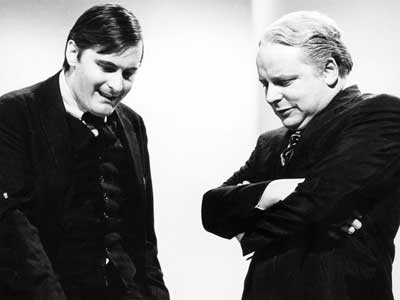
Speaking tongue and cheek about the subprime mortgage crisis in 2008, The Long Johns is a satirical British sketch comedy program which skewers news much like Jon Stewart on The Daily Show is known for, but as they sit and discuss investment bankers, the market, and the simpletons who were presumably duped by mortgage salesmen, they seem to be fairly accurate albeit entertaining.
By late October, countless news programs had gone through the notions of the subprime crisis explanation; even Internet websites like Youtube contained several homemade versions of, what they believed to be, the appropriate and most accurate depiction of the problem. As if it still hadn't been uncovered yet, National Public Radio's 'This American Life' thought many Americans were still left clueless as to what happened, so they created and dedicated two shows to the situation.
But was this enough? The media is known for taking a subject and churning out massive amounts of the same information in all sorts of directions, waiting for the public to take a bite.
In an interview conducted over the phone, Dan Haar, Business Editor and Columnist at The Hartford Courant, said he believed the media did okay with what they were given. “At it's heart, this has never been complicated and the so-called mainstream media had for the most part called it like it is, yet another investment bubble,” he said.
Defining the elements involved in this master scheme, Alex Blumberg, contributing editor of NPR's 'Planet Money', painted a mental picture for his audience in describing the world's collective subset of savings as a 'giant pool of money.' To increase the size of the pool, the bankers who oversee the 70 trillion dollars needed a low-risk, high return investment bubble: mortgage loans. In the first fifteen minutes of this special explanatory report, Blumberg and Adam Davidson had, domino by domino, knocked down the specifics; even translating Alan Greenspan's lingo into lamens terms.
Most programs explained the assembly package process of the mortgages and how they're multiplied and bundled. John Bird, portraying an investment banker, described the package of mortgages as they're moved along to Wall Street: “Suddenly this package of dodgey debts stops being called a package of dodgey debts, and starts being called a structured investment vehicle,” he said. Bird then gave a fake scenario of how an investment banker would buy and sell the 'SIV's' all over the globe. “I will ring up someone in Tokyo and say, 'I have this package, would you like to buy it?' and they, 'What's in it?' and I say, 'I haven't got the faintest idea,' and they say, 'How much do you want for it?' and I say, 'One hundred million dollars' and they say, 'Fine that's it.' The comical rendition of the situation was funny yet simplistic.
A major trend in all financial meltdowns seem to show an increase of explanations and reports after blow ups are reported as extreme; not so much beforehand as the problem intensifies. Explaining that the crisis has unfolded since 2006, Haar said, “The need to understand what happened and the levels and layers of ramifications had evolved, obviously to the point where the problem is far larger than all of the bad mortgages put together.”
Diving deeply into archives of articles regarding the topic, there is mentioning of the subprime crisis spanning back to 2003 when the United States had begun giving out mortgages at minimal conditions; it wasn't till 2006 that the real estate prices increased exponentially and the 'bubble' was created. However, the outdated articles regarding the issue are concise, brief, and bland. “It was less crucial for Americans to understand in those early months,” said Haar. “Most people didn't bother to figure it out.”
Even though the media may have faltered in expanded coverage throughout the course of the crisis in its entirety, they had explained the scenario sufficiently and effectively in the end. The real problem therein lied within Americans. “It is up to each person in society to reach toward an understanding of what's happening in public life,” Haar said. “That didn't happen because the typical person doesn't care enough to do a little bit of work to learn an abstract concept.”
Although admitting that most business writing is bad and news companies tend to abandon their responsibilities of properly covering the news, Haar didn't believe the media failed in regards to explaining the roots of the crisis.
Haar posed a bigger question on whether there is such thing as “the media.” “What is mass media and what is consumer electronics-based communication, in an age of Twitter and iPhones?” he asked. “The breakdown of that distinction, not the failure of professional journalists, is the heart of the reason why the typical person doesn't have the slightest idea what is going on in this world.”











.jpg)
5.jpg)

2.jpg)



